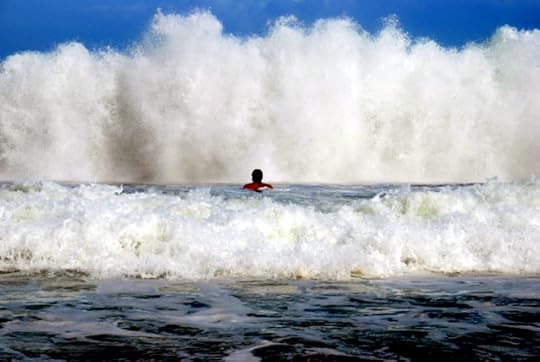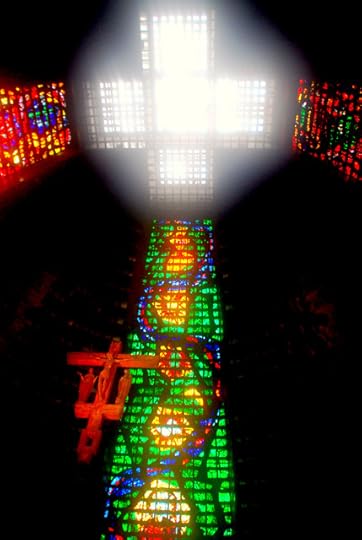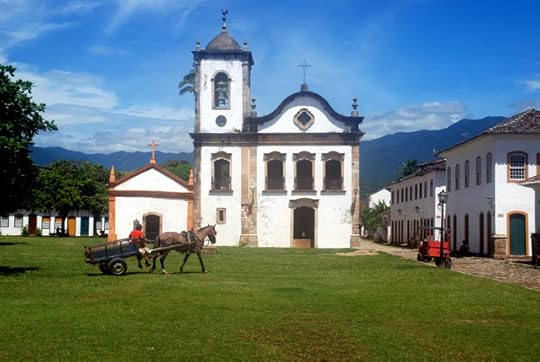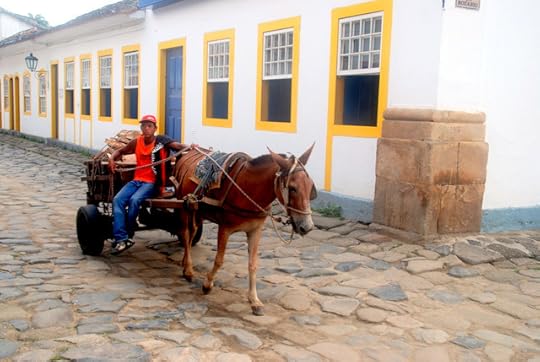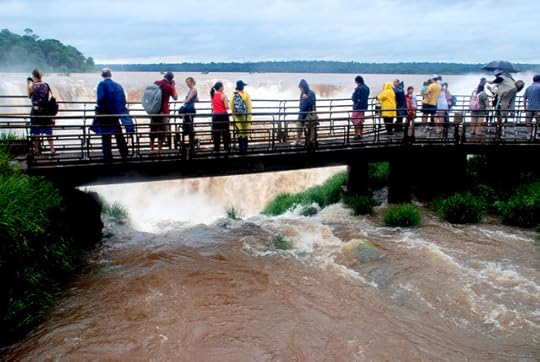Roderick Phillips's Blog, page 24
December 4, 2013
Copacabana beach, Rio de Janeiro, Day 130
In 1502 a Portuguese expedition exploring the coast of Brazil arrived at the mouth of what they erroneously believed to be a great river flowing out into the Atlantic between two headlands (which was later revealed to be Guanabara Bay). The expedition arrived in January and clearly the captain had limited imagination because he named the area January River (Rio de Janeiro).
Brazil is very different to the other South American countries we’ve so far visited. While Spanish-speaking Argentina, for example, has a strong European influence, is wedded to the siesta, and has delicious gastronomic delights at every turn, Portuguese-speaking Brazil (at least in the South) pulses with economic success and wants to emulate if not ultimately overtake North America. Much of Brazil lives on the coast (a long way from the Spanish-dominated interior of South America) and has strong international ties. Admittedly the food in Brazil is nothing to write home about, but Brazilians are very health-conscious and have some of the most beautiful bodies you’ll find anywhere. Rio is also a gregarious city (at least when it isn’t raining) with life played out on the streets – or more accurately on such iconic beaches as Copacabana and Ipanema. Now if the stormy weather would only subside we may actually get to enjoy some of those famous beach bodies – I mean the beach culture.
While I’m dreaming of Copacabana beach, Christi insists on experiencing the local cuisine. She wants feijoada (Brazil’s national dish) at a popular neighborhood restaurant, Marisqueira. Pork stew with rice and beans sounds yummy. What nobody mentions, however, is that the stew contains every part of the pig, including the chewy tails, ears, and trotters. Have you ever had a curly pig’s tail stuck in your teeth? Christi raves about the place, stating that it’s her second favorite restaurant in South America after La Barra in Mendoza, but since she’s been drinking caipirinhas her opinion is suspect.
By the time we’ve finished lunch (and mine goes on long after we’ve left the restaurant), the weather has perked up and we decide to explore Copacabana beach. We even dip our pinky toes into the warm waters of the tropical Atlantic as massive breakers crash along the shore. A few hardy souls make it onto the beach, but there are few sightings of those Copacabana girls I’ve heard so much about (I’m teary-eyed again). Aside from small beach-side shacks selling drinks and snacks there is surprisingly little commercialization of the waterfront – nothing like the Venice Boardwalk experience in Southern California. All in all, though, things are looking up in Rio.
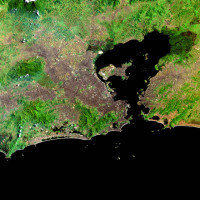

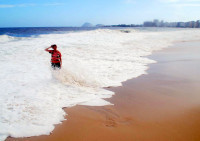



Blog post by Roderick Phillips, author of Weary Heart, a gut-wrenching, heart-wrenching, laugh-wrenching tale
The post Copacabana beach, Rio de Janeiro, Day 130 appeared first on Roderick Phillips.
December 3, 2013
City tour, Rio de Janeiro, Day 129
We wake to find heavy rain pelting the Wave Hostel (outside and in). Rio in the rain is dismal. Rio in the rain while enduring cheap, damp, squalid accommodation almost reduces Christi and I to tears. Ever hopeful, we join our city tour which promises spectacular panoramic views of Rio from Christ the Redeemer on Corcavado Mountain and the reverse view from Sugar Loaf Mountain in downtown Rio. We begin at Rio’s enigmatic Metropolitan Cathedral, however. From the outside the cathedral is a truly ugly concrete pyramid, but the inside is breathtaking : four beautiful stained glass windows that rise over 200 feet to a cruciform ceiling of light – absolutely stunning.
We continue through the rain to the nearby samba museum. According to our guide, Myriam, there are 14 samba schools, each affiliated with a favela (shantytown) and each with thousands of members. Despite their poverty, these schools make the elaborate floats and costumes that dazzle the world during Carnaval. And some of the costumes are on display in the samba museum.
No city tour of Rio is complete without a visit to the Maracana football stadium – a temple of worship for the soccer-crazed Brazilians. However, the day of disappointments continues as the cost of our tour (a whopping US$50pp) does not include entrance into the stadium. And we have no time to look around anyway. Wait…What?
The day continues on its southerly trajectory as the iconic views of Rio from Corcavado Mountain and Sugar Loaf Mountain are lost beneath torrential rain, dark clouds, and fog (the tears are real this time). Unwilling to return to our fetid hostel room, Christi and I beg our tour guide, Myriam, to find us alternative accommodation – and now we’re willing to throw any amount of money at the problem (well Christi’s card anyway). For the remainder of the tour, therefore, poor Myriam has her head glued to the phone, very occasionally looking up to describe a point of interest, while receiving rejection after rejection from every hotel in Copacabana and Ipanema until at the eleventh hour the hotel Apa has a cancellation and we’re in. It’s at the dodgy end of Copcabana to be sure, near a favela, but on offer is the holy trinity of accommodation: air-con, cable TV, and hot water! We’re now dry and warm, which offsets the disappointment of Rio in the rain a little.
By the way, hotel rooms in Rio are at such a premium currently not only because of the rapidly approaching Holiday season, but because of a major soccer event. Arguably the most popular team in Brazil, Flamengo of Copacabana, have a chance to win its first national title in decades by beating Grêmio at the Maracana stadium in the last game of the season in a couple of days. Fanatical supporters are flooding into Rio from all over the country snapping up accommodation and sending ticket prices into the stratosphere. Passion has reached fever pitch and I’m repeatedly advised to watch the game on TV from the (relative) safety of a bar. This is hugely disappointing. Boca Juniors were out of town the weekend I was in Buenos Aries and now the biggest game in Rio in years is pretty much off-limits.



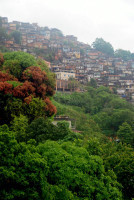
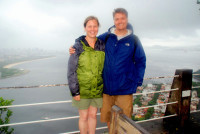
Blog post by Roderick Phillips, author of Weary Heart – a gut-wrenching, heart-wrenching, laugh-wrenching ride
The post City tour, Rio de Janeiro, Day 129 appeared first on Roderick Phillips.
December 2, 2013
Santa Rita church to the temple of Rio, Day 128
Before boarding the mid-morning bus from Paraty to Rio de Janeiro, the sun finally breaks through the clouds and I race around the waterfront photographing everything from colonial houses to the harbor and the picture postcard view of Santa Rita church. Collapse, perspiring, into the air-conditioned bus. Sometimes you just have to hustle to get good photos!
It’s a 4.5-hour ride to Rio and the first half is spectacular as we drive between incredible tropical rainforest and beautiful beaches, lagoons, and islands. Our approach to Rio is laced with gritty slums and a sense of despair, however – definitely not the tourist view of the city. The bus station is equally seedy, but a friendly cab driver whizzes us to our accommodation in Copacabana. The beach is a perfect sandy bay with Sugarloaf Mountain dominating the skyline. Sadly, our hostel, The Wave, is dire. Our room is a stifling sauna; even the sheets on the bed are sticky to the touch and we’re forced to unroll our sleeping bags – something we haven’t done since hiking the Inca trail. There is an overhead fan, but this merely moves the humidity around, while the door to the bathroom is hanging off its hinges. The staff are unsympathetic and unhelpful.
Why are we even staying here you might ask? There are several reasons. First, Brazil is much more expensive than the other countries we’ve visited so far. Second, we’re in the run up to Christmas and accommodation is at a premium, and third, poor financial management. During our initial trip planning we calculated we could get by in the Andean countries on less than our daily budget of US$100, thus giving ourselves some breathing space in the more expensive countries such as Brazil. Unfortunately we were seduced by the relatively luxurious lifestyle afforded to us in Ecuador, Bolivia, and Peru and spent to our limits. Now we’re paying the price. We look for alternative accommodation in Copacabana, but find nothing. We do, however, sign up for a tour of Rio tomorrow. And unlike Buenos Aires, we’re doing this city tour at the beginning of our stay – smooth, huh.
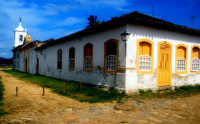
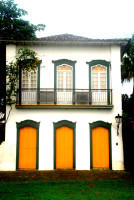
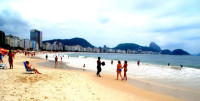
Blog post by Roderick Phillips, author of Weary Heart, a gut-wrenching, heart-wrenching, laugh-wrenching tale
The post Santa Rita church to the temple of Rio, Day 128 appeared first on Roderick Phillips.
December 1, 2013
Paraty, Costa Verde, Brazil, Day 127
Paraty (meaning river of fish) is located on Brazil’s southern Costa Verde (Green Coast). It was founded in the 17th century by the Portuguese as a port to carry the huge gold deposits mined in the interior to Rio de Janeiro and return supplies and African slaves to the mining area of Minas Gerais. Gold extracted by slaves in Brazil funded the Portuguese empire in the same way that silver extracted by slaves in Bolivia funded the Spanish empire.
Times change, of course, and Paraty’s new claim to fame is tourism. Wandering around the historic center is like taking a step back in time with its cobbled streets, colonial architecture, and weather-beaten churches. The only thing missing (from a locals’ perspective, at least) are the tourists. The open-air restaurants and sidewalk cafes are quiet and listless, while the harbor is bursting with brightly colored schooners that no-one wants to hire. Even this does not appear to faze the laid-back locals, though, who wait patiently for the good times to roll around. And that occurs, apparently, when the Rio crowd comes to party at the weekends and the period between Christmas and Carnival. But for now, you would be hard-pressed to find a more relaxed, idyllic town to explore – or a more idyllic location than Costa Verde. The village is surrounded on three sides by thick, dense tropical rainforest, while the Bay of Ilha Grande literally laps gently at the doorsteps of the village shops. Indeed, 17th century Portuguese engineers built Paraty in such a way that at full moon high tides could enter the town and clean the streets. Then, as the tide receded again, the town’s garbage was neatly swept out to sea. I’m presuming the town has come up with a more environmentally friendly waste removal system now, but the flooding still occurs. It’s a pleasure to amble along these historic streets and squares, poking around the shops, and relaxing with a caipirinha or two. We eat a rather tasty dinner of garlic shrimp and rice at Candeeiro and listen to the local samba music while the stars shine and the moon smiles blissfully down upon us. (Note caipirinha translates as ‘a country girl’. It’s amusing to listen to Christi craving ‘a country girl’!).
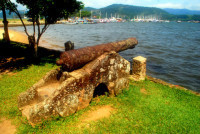
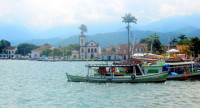


Blog post by Roderick Phillips, author of Weary Heart – a gut-wrenching, heart-wrenching, laugh-wrenching ride
The post Paraty, Costa Verde, Brazil, Day 127 appeared first on Roderick Phillips.
November 30, 2013
Trindade, Costa Verde, Brazil, Day 126
Our room at the Geko Hostel in Paraty lacks air-conditioning, but the one fact of life we are rapidly adjusting to is the inflated cost of living in Brazil versus Argentina, which is straining our very meager budget to the limit. For this reason we walk passed the schooners at the waterfront offering expensive, full-day tours to isolated idyll tropical beaches (of which there are many around Paraty) and back to the bus station. Apparently, the beach to visit is Trindade, which is a 45-minute bus ride away to the southwest. The bus is something straight out of Romancing the Stone as it bumped, growled, and wheezed its way along jungle tracks, up and down steep hills, and through tiny villages. The passenger screams remind me of a Six Flags rollercoaster ride.
After all that, Trindade is a sleepy, one street town blessed with stunning tropical beaches. Some of the beaches have the classic palm-frond thatched roof bars, lazy music and equally laidback staff, but beyond them (through the jungle) are truly pristine stretches of white sand that unite the steaming verdant rainforest with the calm, clear aquamarine waters of the Atlantic (which are pleasantly warm). Perhaps because it’s the middle of the week, but the beaches are virtually deserted. Christi is surprisingly excited and can’t wait to dive in. And while she does just that, I explore the full scallop-shaped curve of the bay, looking for suitably idyllic shots.
After we both swim and splash around for a bit, it’s back to the populated beaches for a healthy fruit and veg meal at a waterfront bar. And it is here that Christi discovers the celebrated cocktail caipirinha, a rum and lime juice delicacy that she proclaims de-licious.

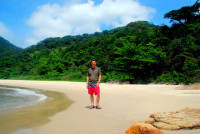
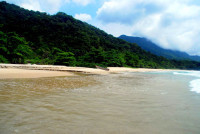
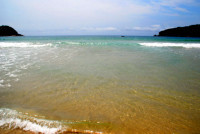
Blog post by Roderick Phillips, author of Weary Heart, a gut-wrenching, heart-wrenching, laugh-wrenching story
The post Trindade, Costa Verde, Brazil, Day 126 appeared first on Roderick Phillips.
November 29, 2013
Paraty, Brazil, Day 125
Destination Paraty on Brazil’s Costa Verde (Green Coast).
The alarm goes off at 2 am and Christi and I silently pack and leave not only the Marco Polo Inn, but Argentina. Neither Argentinian nor Brazilian immigration appears to care that we only crossed the border 8 hours ago and we taxi smoothly on towards Foz do Iguacu airport. This border hopping may seem a convoluted way to experience the Brazilian side of the falls, but it truly was the most economic and efficient way to do it. And this is true for the wetlands as well. Both Argentina (Esteros del Ibera) and Brazil (the Pantanal) have world-class wetlands, but it was much cheaper to visit the Argentine version. Having now visited the falls and the wetlands we are done with this tripartite border region where Argentina, Brazil, and Paraguay collide.
Although Brazil is the largest country in South America, we will only stay long enough to hit a few of the highlights. To that end we fly from Foz do Iguacu to Sao Paulo in under 2 hours (compared to a 16-hour, overnight bus ride). The only way to describe Sao Paulo is a megalopolis. It is a vast concrete jungle with more potential dangers than the Amazon. It is the largest city in Brazil and the world’s seventh largest city. It would take a lot of time to explore and try to understand this complicated environment, and to be honest we don’t have the time or the inclination. Therefore we stay in Sao Paulo only as long as it takes to transfer from the airport to the major domestic bus station. We have 30 minute wait at Tiete bus station for the first bus to Paraty. We immediately notice differences to Argentina. Bus rides are much more expensive and on this 6-hour ride at least, it does not come with either food or a movie. And, of course, Brazil is the one major country in South America that does not speak Spanish. Our limited Spanish is now useless as we struggle to understand the bus driver make announcements in Portuguese. Having said that, it’s a pretty ride along the Atlantic coast and beside the remnants of the Atlantic rainforest. After a few false starts we do eventually leave the bus at the correct destination, the small, picturesque seaside town of Paraty. Paraty is close enough to Rio that on weekends it can become over-crowded, but mid-week (i.e. now) it is tranquil and idyllic.
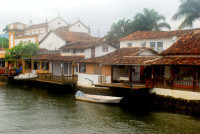
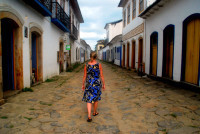
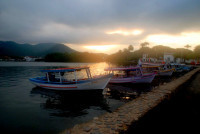
Blog post by Roderick Phillips, author of Weary Heart, a gut-wrenching, heart-wrenching, laugh-wrenching ride
The post Paraty, Brazil, Day 125 appeared first on Roderick Phillips.
November 28, 2013
Iguacu Falls, Brazil, Day 124
While Argentina gives you an up close and personal view of Iguacu Falls, Brazil offers them in all their 3D, panoramic splendor. You have to see the falls from both sides to get the complete, breathtaking experience. Believe it or not, time is becoming a slight issue for us so rather than dally on the Brazilian side of Iguacu falls, Christi and I are taking the one day, 3-country tour. The advantage of trips such as these is that they cover a lot of ground in a short amount of time. The disadvantage is that they cover a lot of ground in a short amount of time. Christi and I are, by nature, more tortoise than hare, but needs must when the devil drives. Hold on tight because here we go.
For the third time (twice with Chile and now once with Brazil) we have to endure immigration formalities to escape Argentina and then of course to go through the same rigmarole again to enter Brazil at Foz do Iguacu (with more stamps in our tattered-looking passports). Our multi-national, multi-country tour spends an inordinate amount of time picking up passengers in various countries, before actually showing us anything remotely interesting. Christi and I only want to visit the Brazilian side of Iguacu Falls, but that is the tour finale. We begin, not in Argentina or Brazil, however, but neighboring Paraguay. It appears that entrance into Brazil gives you a free pass into its smaller neighbor – our passports are not checked and we don’t even stop!
The reason for visiting Paraguay is the Itaipu dam. This dam and hydroelectric project provides 80% of Paraguay’s electricity needs and 25% of Brazil’s. It’s the second largest dam in the world (after China’s Three Gorges project) producing 14,000 megawatts annually. The costs – both environmental and financial – were huge. Tens of billions of US$ were spent on construction, while Sete Quedas (arguably the most spectacular water fall in the world – even more impressive than Iguacu Falls) were destroyed. The visit to Itaipu passes in the blink of an eye and then we’re forced (like hard labor) to spend a long dull hour shopping in the Paraguayan border town of Cuidad del Este in abysmal heat. The only ineteresting apsect to this stop were the security guards that were stationed outside every flea-bitten store. They were carrying pump-action shotguns!
Back to Brazil for an all-you-can-eat buffet lunch which was, admitedly, excellent, but it was also the longest stop on the entire tour. Certainly the tour guide and driver were in no hurry to leave – bastards! By the time our tour party finally reaches the Brazil side of Iguacu Falls (and I’m pulling my hair out at this point) we have only 1 hour to enjoy the superb panorama of Devil’s throat and the other cataracts. It’s so frustrating to have so little time on this ‘all-day tour to Iguacu falls’. Get pleasantly drenched, which is very refreshing. Christi and I incur the wrath of the tour guide by being, by some time, the last people to return to the coach. Well bloody good! Return to Puerto Iguacu via Brazilian and Argentinian immigration, although our time in Argentina will be brief. We need to be back in Brazil in about 8 hours to take a flight from Foz do Iguacu to Sao Paulo.
Thank you, Argentina, for a fantastic experience: from the dazzling colors and rock formations of the northwest desert, to the dramatic glaciers and rugged hiking of the far south, and the steamy jungle and mighty waterfalls of the northeast – not forgetting the parillas and the wine and the wildlife. What an amazing country.

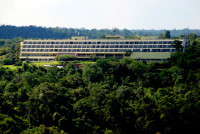
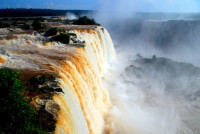
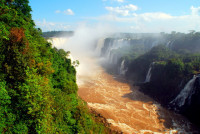
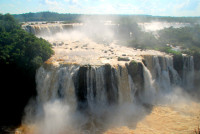

Blog post by Roderick Phillips, author of Weary Heart – a gut-wrenching, heart-wrenching, laugh-wrenching tale
The post Iguacu Falls, Brazil, Day 124 appeared first on Roderick Phillips.
November 27, 2013
Macucu nature trail, Iguazu falls NP, Day 123
Ambitious plans for an early morning hike along the Macucu nature trail in Iguazu Falls national park this morning, but our-conditioned double-room is just too good to leave. Only very reluctantly do we pack yet again and then ask the staff at reception whether there are any private rooms available or whether it’s back to communal living tonight. Christi and I may live in San Francisco, but hippies we ain’t. I don’t mean to knock the whole dorm experience, but been there, done that. Now I crave a little privacy and as much comfort as my limited budget can manage. In any event the Gods are smiling on us. The staff at reception do have a double-room available for the next 2 nights and we jump on it. Yippee!
Return to Iguazu Falls national park with renewed enthusiasm. Arriving at mid-morning is much more low-key than yesterdays early morning escapade. Today there is no race for the train or Garganta del Diablo. Our main aim today is to hike the Macucu nature trail; it’s an easy 2-mile walk, best undertaken in the early morning. By the time we find the trail and begin to hike it’s approaching midday, which is bad news for animal spotting and for hiking in general. You won’t be surprised to learn that it is very hot and humid; the sweat is just dripping off Christi and I. Christi in particular says she dislikes high humidity. There are also a fair few bugs and not wanting a repeat of my nighttime disasters in the Esteros del Ibera we cover up and use liberal amounts of bug spray. Mind you, DEET, is not exactly a healthy alternative to mosquito bites. Nevertheless it’s a pleasant amble well away from the huge crowds visiting the falls themselves. Supposedly, the Macucu nature trail is a wildlife hot spot, but sensibly all the critters are sheltering from the oppressive heat and humidity. Our only encounters are a coati and a miniature scorpion. The end of the trail overlooks the Arerechea waterfall. We paddle in the splash pool above the falls while eating lunch (in the company of friendly lizard) and then wander back to the trail head. The jungle is dense either side of the trail, but we do manage to spot a woodpecker and some capuchin monkeys.
We are unbearably hot and sticky when we finally stagger back to the service area just beyond the trail head and are glad to indulge in some delicious air-con and cold drinks. Later we retrace our steps along the Circuito Superior. The crowds have thinned appreciably and we take our time and enjoy the moment. The wildlife here is actually more abundant than on the nature trail – mostly, I think, because the tourists feed the animals. More pretty butterflies and a kumquat-eating iguana are the pick of the wildlife encounters.
Take the public bus back to the Marco Polo Inn and check-in to our third (and last) different bed. Shower and air-con (when it’s switched on at 7 pm) are utter bliss. Have dinner at a poor man’s parilla tonight; the meal is only memorable because a lot of it ended up in a cat that Christi befriended.

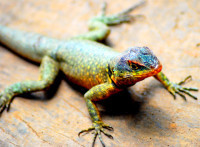

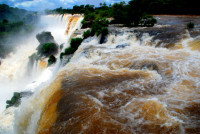
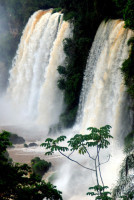

Blog post by Roderick Phillips, author of Weary Heart – a gut-wrenching, heart-wrenching, laugh-wrenching ride
The post Macucu nature trail, Iguazu falls NP, Day 123 appeared first on Roderick Phillips.
November 26, 2013
Iguazu Falls national park, Argentina, Day 122
Enjoy a mediocre night in dorm-land. Thankfully the staff at the front desk inform Christi and I that a double room is available for tonight, so we rush back to our dorm, quickly pack our bags (while hopefully not disturbing our still snoring dorm-mates) and put our packs in storage. Follow this with a quick breakfast and then catch a bus to Iguazu Falls national park, some 15 km away, in buoyant mood.
We arrive just as the park is opening for business. Unfortunately Christi and I are not the only ones seeking early morning solitude as many tour buses arrive simultaneously. Our immediate goal is Garganta del Diablo, the horse-shoe-like part of the falls that are similar to Niagara. An uncomfortable toy train full to bursting ferries eager visitors ever so slowly to Garganta station and from there it’s another click along a walkway over the superior Iguazu River to reach the falls themselves. And they are mighty impressive: the walkway is perched literally over the falls in places and we are drenched repeatedly as the spray mushrooms up from the base of the churning monster. It is also crushingly loud, but really there is no need to talk here. It’s all about soaking up the atmosphere and the spectacle. Across the falls from our viewpoint is the Brazilian side of Iguazu (70% of the falls belong to Argentina, a mere 30% to Brazil). We will explore that side in a few days.
Butterflies offer a delicate counterpoint to the power of Iguazu falls, but both live in harmony with one another. Indeed, I have never seen so many butterflies before and they are quite fearless, landing on us and using their long proboscis to extract salt and other minerals from our skin. The photographic opportunities in Iguazu Falla national park are as immense as the falls themselves.
Next up we take the Circuito Superior to view another set of waterfalls. Along the way we see lizards, more butterflies, iguanas, and coatis (members of the raccoon family). By this point it’s mid-morning and the real tourist hoards descend – wave after wave of buses disgorge their contents making it impossible to photograph anything or to enjoy a few tranquil moments in this little slice of heaven. We escape the turmoil and enjoy some much-needed air-con and cold drinks at the Sheraton hotel, which is actually located inside the park. We even stay for a turkey club lunch turning our brief visit into an expensive slice of luxury (A$100).
Back out in the real world of oppressive heat and excessive tourists (and I don’t know which is worse) we take the last of the major waterfall trails, Circuito Inferior – not that there’s anything inferior about the views at all. They are close-up, spectacular vistas. It is also possible to take the walkway to beneath Bossetti waterfall, which gives off a cool refreshing mist. And not content with drenchings we have received today we decide to take a speedboat ride into the Devil’s throat and the Adam and Eve falls (A$100; 12 mins). The force of water plummeting over the falls is terrifying. It’s hard to breathe let alone keep my eyes open as the monstrous flow of water pounds the rocks all around me. I think I’ve just paid to be water-boarded!
Tired, wet, and hot we decide to call it a day and return to a deliciously cool double-room at the Marco Polo Inn. Lie there and let the cool air envelop me, but the pleasure is only temporary as we have to give up this room in the morning. And who knows where we’ll sleep tomorrow night.

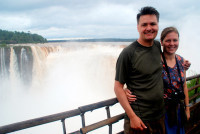
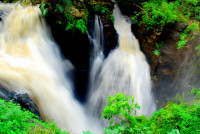

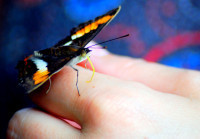

Blog post by Roderick Phillips, author of Weary Heart – a gut wrenching, heart-wrenching, laugh-wrenching tale
The post Iguazu Falls national park, Argentina, Day 122 appeared first on Roderick Phillips.
November 25, 2013
Puerto Iguazu, Argentina, Day 121
Collect my newly repaired Tevas and then Christi and I board a fast bus to our next destination, Puerto Iguazu. The bus drivers in this part of Argentina have clearly been affected by the incessant tropical heat and watching too much Nascar, because they drive erratically and they drive fast. Having said that we still arrive late into Puerto Iguazu, but we are alive as we take the checkered flag.
Accommodation in this town is hard to come by in our price range (somewhere between beggar and pauper) and the only availability is a dorm bed at the Marcopolo Inn. Fortunately, the inn is directly across from the bus station, which means we don’t have to lug our bags too far. This is just as well because the heat and humidity around here are fierce. We dump our bags in room 8 (a 5 bed dorm) and begin our exploration of the town. For a premier tourist destination it is surprisingly compact and low-key. There is nothing to suggest that one of nature’s greatest natural wonders, Iguazu Falls, is just up the road. After organizing transport to the falls for tomorrow, we look for ways to escape the heat. Not surprisingly, the siesta ia alive and well in Puerto Iguazu (I mean who has the energy to do anything here?) and there’s not much open. We eventually find a restaurant, Cafe Bonafide, which has its air-con set to arctic, which is sheer bliss. I almost feel we’re back in Tierra del Fuego. Cafe Bonafide is actually more of a chocolate shop than restaurant, but the staff do rustle up some sandwiches in addition to the delicious tiramisu we order. It amazes me that in this steamy climate, cafe Bonafide proudly offers hot tea, coffee, and chocolate and people are buying it. We stick to ice-cold coca cola, which is damn refreshing.
We plan to devote the next few days to exploring Iguazu Falls so the remainder of today is consigned to doing chores, most notably continuing our frustrating attempts to organize future activities in Venezuela, travel to Colombia, and, in two months from now, flights to Accra, the capital of Ghana (in West Africa). Fail miserably. Perhaps its the destinations I’m choosing, but US-based companies want nothing to do with Venezuela, Colombia, let alone most of Africa. Resolve to make my next vacation destination Hawaii – just kidding! The day is somewhat rescued by a delightful dinner of lamb stew (Christi) and roast pork (me). We then return reluctantly to the cozy 5-bed dorm room, where our dorm mates are all snoring contentedly.
Blog post by Roderick Phillips, author of Weary Heart - a gut-wrenching, heart-wrenching, laugh-wrenching tale
The post Puerto Iguazu, Argentina, Day 121 appeared first on Roderick Phillips.

